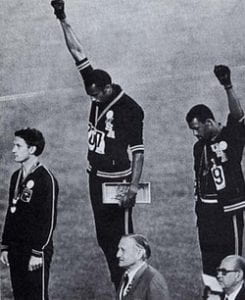Context:
- Photograph taken during the 1968 Mexico City Olympics of Tommie Smith and John Carlos.
- Both raising fists and performing the black power salute during the national anthem.
Reception:
- Jeered and insulted by 50,000 attendees (racial slurs, etc)
- Both suspended from the US Olympic team.
- Sparked enormous political controversy in the US.
Stylistic Features:
- Picture itself portrays the black athletes to be above the white athlete.
- Black and white photo provides a greater contrast between them.
1st Paragraph: Representation of black people, context
2nd Paragraph : Underlying values and beliefs, implications in the future, civil unrest at the time,
When we begin to consider how critical moments in history often have the ability to reflect and represent cultures, only some examples are as prevalent as that of Tommie Smith and James Carlos, with their unforgettable story of passionate rebellion in the face of unrelenting repression. Having placed first and third respectively in the 200-meter sprint during the 1968 New Mexico Summer Olympics, Smith and Carlos proceeded to raise their black-gloved fists during the national anthem as an elaborate form of silent protest, all in an effort to shed light upon the mistreatment and subjugation of African-American citizens living in the United States. The fallout of this moment was indeed quite catastrophic, resulting in nearly 50,000 attendees jeering, insulting and shouting heinous racial slurs at both athletes. Furthermore, Smith and Carlos were suspended from the U.S Olympic Team, with many publications at the time comparing their salute of equality to that of “Nazi” proportions.
Points in U.S history such as these have consistently brought the tulmotous issue of race back to the fore of people’s attention. Having the event take place only months after the assasination of Martin Luther King Jr, civil unrest and racially-driven riots were at an unprecedented level. Despite the increasing levels of tension between the 2 groups, Smith and Carlos remained undeterred in their values and motivations. They were compelled to keep fighting due to an instinctual responsibility they felt adhering to problems which resembled their own identity and perspective, not to mention their personal experiences of racial persecution and abuse. These beliefs are still relevant to this day, with many of the socio-economic consequences of their actions carrying forward to today’s modern, “equal” society.

